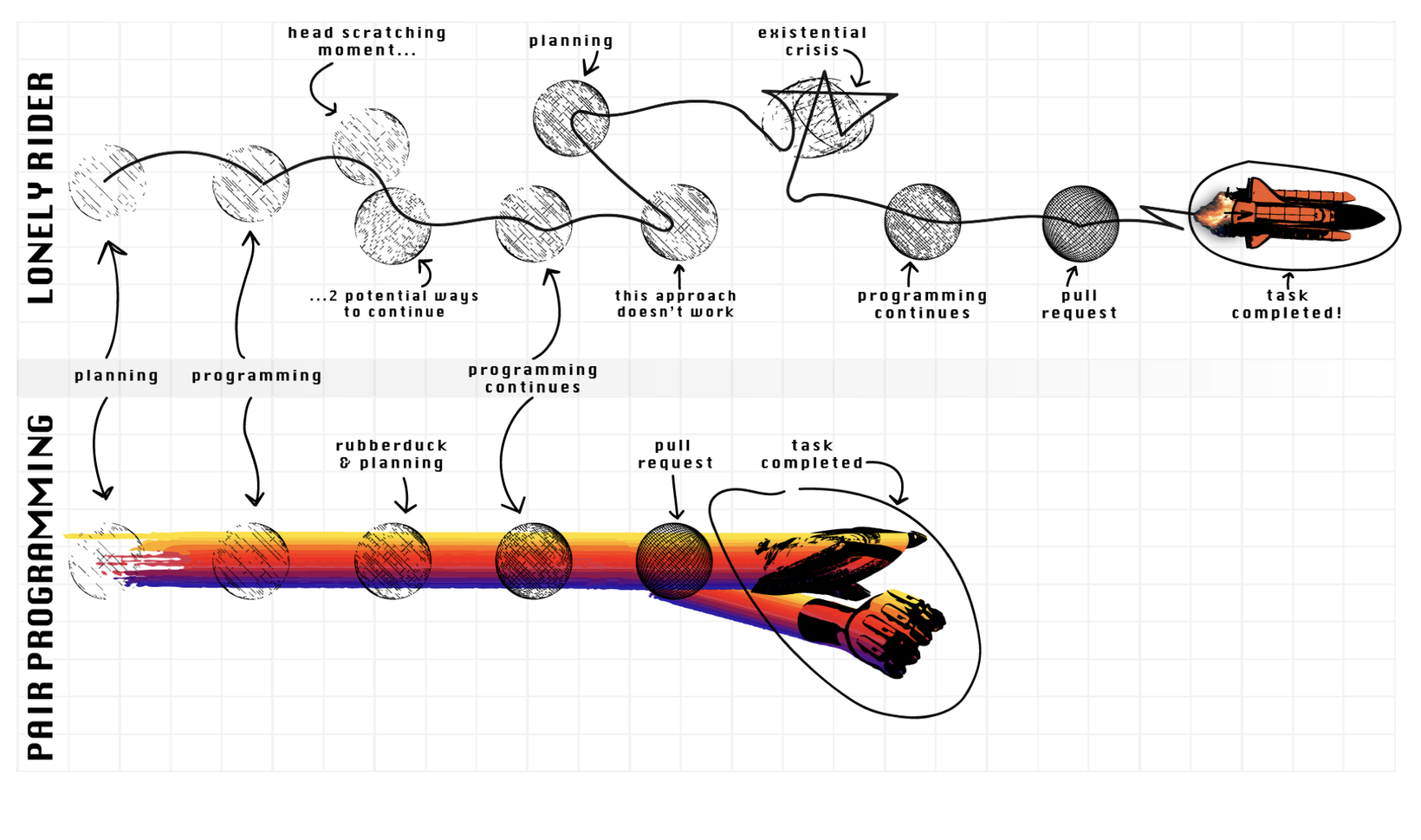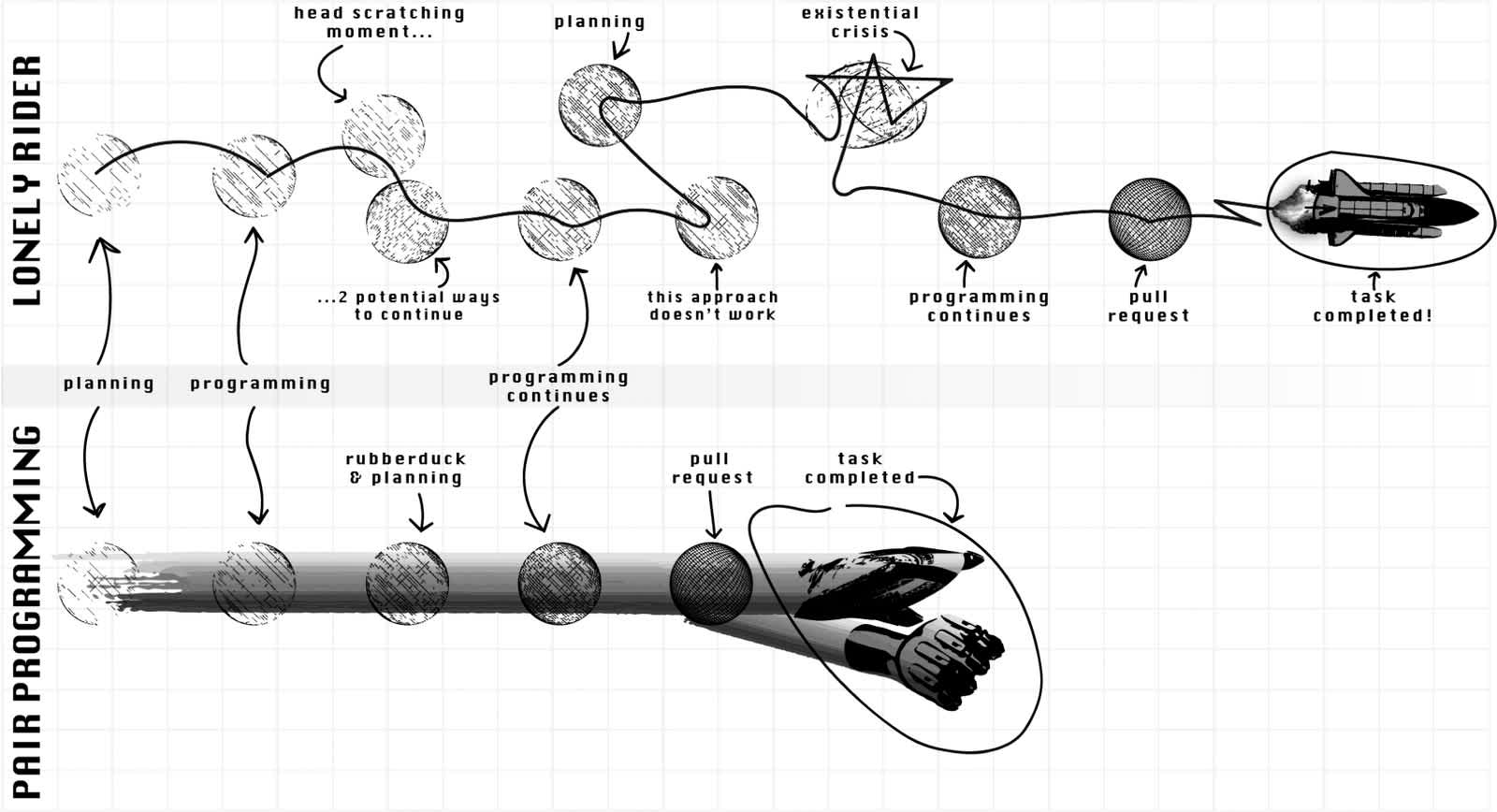This is part I of our “Pair Programming — Uncharted Territories” blog posts. See also Part II.
You all know that trustworthy buddy who may not be your best friend but who is always ready to listen to you when you feel that your life is not going as expected? Yes, it is pair programming. It feels often quite distant, albeit when you happen to practice it, you might wonder why you do not hang out with the peer more often.
We know that when the size of a programming team increases, its relative efficiency often drops. So is pair programming doomed to be a method used only in special cases? A well-known software developer Martin Fowler has a rule of thumb which says that the efficiency of a programming team is the square root of the number of the programmers. For example, if a team consists of two programmers, the real efficiency would equal 1.4 times a single programmer. Question is, can you surpass this limit with pair programming?
We believe you cannot only surpass it but surpass it clearly — if some conditions are met.
In this first part, we will go through the advantages of pair programming. In Part II , we list different levels of pair programming and explain what is needed to fine-tune your pair programming from Opel Astra to Bugatti Chiron!
PROS
Efficiency
Tasks given for the programmers usually consist of subtasks. For each of those subtasks, programmers have some probability of getting stuck. Let’s say a typical programmer has about 20% probability to get stuck in a single subtask during a task. Hence, if you have three spots where you could get stuck, you have a total of about 50% probability of getting stuck during the whole task. However, if there are two pair programmers who perceive the problems from different angles, the probability that neither of the peers solves a problem straightforwardly is 4% (20% x 20%), and during the whole task about 11%. Why is this important? Because most of the programmer’s time is spent when being stuck of some level. Successful pair programming removes many of those time- and energy-consuming periods.
And there’s more to this. The following figure visualizes a simple comparison of possible timelines for developing a task in a solo-mode and by pair programming.

Decently distributed codebase knowledge
Nowadays development teams are quite well aware of the importance of not having parts of the codebase that are understood only by one developer. A common way to take care of this is to have peer reviews. However, when pair programming, knowledge is spread already in the programming phase — resulting in a much higher level of code knowledge for the pair programmer compared to peer reviewer. Practically both of the pair programmers end up having a deep understanding of the code — which will stay in memory for quite a long time. And the peer review — if it is needed at all — will be noticeably faster.
Cabin Fever Medicine
When you write code alone, you need to make numerous small decisions, starting from a single line of code. Many decisions will remain in your head causing scruples about whether you did it right or not and making it harder for you to focus on the next tasks. You might lose your perspective, get cabinet fever symptoms and make decisions that look weird to others. In pair programming, your mate may point out if you start to depart from the path. You will also stay sane because you are able to share your thoughts (programming-related but also other) continuously.
24/7 Rubber Ducking
When pair programming, you are using your peer as a rubber duck most of the time. This means that when you have programming-related thoughts, problems or solution proposals, you say them out loud. By doing this you may twig something you haven’t realized before.
Sparring
It is quite typical that when programming you end up spending your time by weighing up various alternatives for a variable name or something similar. “I feel this isn’t perfect… I can’t make up any better one though…”. However, you can quickly discuss this kind of things while pair programming.After receiving support from your peer that the variable name is excellent, you can leave the whole thing behind and push forward.
Effortless Micro Take-ups
Everybody knows the feeling when a task is yet to be started and is waiting like a monster, and you are tempted to open a social media channel or news site or you just drown in your thoughts. Pair programming, in turn, has partial built-in prevention for that because you are subconsciously aware that it will be twice as expensive to stop programming because you will also stop your peer’s work at the same time. When something, small or big, gets done, the presence of your peer urges you to move to the next task right away. Besides, slaying a dragon is much more fun to do with a friend than alone!
Actually, just like every task consists of smaller tasks, every take-up consists of multiple smaller take-ups, micro take-ups. A micro take-up can mean starting to write a small function you need. Or sending an email. Or opening your backlog. As you might have noticed, micro take-ups get more expensive towards the afternoon, for example, but also because of a variety of other reasons. In fact, a high price of micro take-ups may significantly slow down your programming progress. Pair programming is a great aid for this matter since it strikes right at the potential source of inefficiency.
Now let’s continue to Pair Programming — Uncharted Territories Part II in which we explore the different levels of pair programming.
